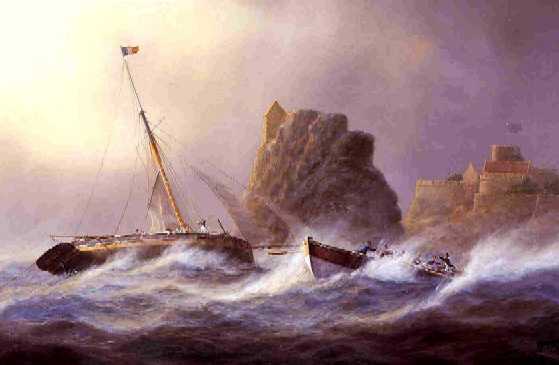|
|
|
Captain Destouches and the wreck of the Fanny 1825

It was at 6 o'clock on Friday 7th January 1825 that a cutter called the Fanny en route from St Malo to St Helier ran onto the rocks called Les Buts behind Elizabeth Castle. Although Captain Destouches knew the waters the storm had whipped the waters into a boiling mass and it was causing him all sorts of problems. As there was no organised lifeboat at that time it was up to volunteers to try to rescue the passengers and crew. Philippe, François and Jean De Ste Croix and Philip Nicolle organised a boat which made two trips out to the wreck where they saved 13 passengers. The Fanny slipped off the rocks and broke up before the rescuers could return for a third time. Unfortunately, six people including a little girl drowned before they could be saved.
The National Institution for the Preservation of Life from Shipwreck which had been founded the previous year awarded gold medals to the three de ste Croixs and a silver medal to Nicolle in recognition of their bravery. As Philippe Jolin and George Marshall, the other two men on board, were "persons in a humble sphere of life", it was thought more fitting that they should be rewarded with three sovereigns each - this represented about four weeks wages for a shipyard worker in the island.
This was not the last of Captain Destouches and the Fanny, however. It is possible that the Fanny was salvaged and rebuilt as on Wednesday 2oth November 1827 Captain Destouches and the crew of the Fanny rescued the seven passengers and the crew of the cutter Mercure on passage from St Malo to St Helier which had been wrecked on the Minquiers.
On 1st January 1828 Captain Destouches managed to lose his new cutter, also called the Fanny, on the rocks about a mile outside St Helier in another storm but this time he was not so lucky as 11 passengers and two of his crew drowned although this Fanny was later salvaged and beached at Havre des Pas. Although Destouches had reached St Helier safely he had to anchor in the roads to wait for the tide to enter the harbour. A few passengers had disembarked on a small boat to the low water landing stage but most were still on board. A violent storm blew up very quickly and the Fanny lost her anchor and was blown onto the rocks around the Dog's Nest. Amongst the dead was Lord Harley and a number of Jerseymen who were actually drowned while their horror stricken relatives stood helpless within calling distance. It was this disaster that prompted a member of the Harbours and Piers Committee, Sir John Le Couteur, Constable of St Brelade, to raise the matter of the need for a lifeboat in the States.
One of the men at the oars in 1825 incident had been Philippe Jolin. In 1829 he murdered his father when they were both drunk. He was the last man to be publicly hanged from the gallows on West Mount. His last view of his island home was Elizabeth Castle and the scene of his heroism.
Return to
Tales of Ships and Shipwrecks